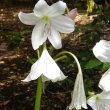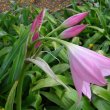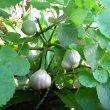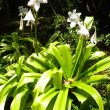Crinum moorei
| Botanical Name | Crinum moorei |
|||||||||||
| Family | Amaryllidaceae - The amaryllis family. |
|||||||||||
| Pronunciation | KRYE-num MOOR-eye |
|||||||||||
| Common Name(s) |
English: Natal lily; Inanda Lily; Ngomi Lily
Afrikaans: Boslelie; Natal-lelie; Ngomilelie; Rivierlelie
IsiXhosa: ibhucu
|
|||||||||||
| Plant Group |
|
|||||||||||
| Plant Size |
|
|||||||||||
| Position |
|
|||||||||||
| General Information |
|
|||||||||||
| Specific Information | The bulbs of Crinum Moorei are large, measuring up to 200 mm in diameter. A 'neck' of about 250 mm long extends from the , which lies just below soil level. The long, wide green leaves grow in a rosette shape from the top of the neck. The leaves can be up to 1m long and 200 mm wide! The flower stalk grows up 1,2m tall, topped with 5 to 10 large, slightly drooping flowers. The leaves die off after flowering. This Crinum does not tolerate direct sun. It will tolerate light frost but should be in a sheltered position to protect the dormant bulbs from harm. The flowers are perfumed, more so in the evening. Crinum Moorei is listed as vulnerable, as populations are declining due to harvesting for the medicinal plant trade and the negative effect of the amaryllis caterpillar. |
|||||||||||
| Ad Break | ||||||||||||
| Flowers | ||||||||||||
| Description | large trumpet shaped blooms in loose heads on long, sturdy stems |
|||||||||||
| Season |
|
|||||||||||
| Colour |
|
|||||||||||
| Growth Rate |
|
|||||||||||
| Plant Uses |
|
|||||||||||
| Distribution and Habitat | the Wild Coast of the Eastern Cape and coastal KwaZulu-Natal as far as Ngome, in coastal, marine and scarp forests, and in damp or marshy places along watercourses |
|||||||||||
| Planting Suggestions | Plant in full or dappled shade in good garden soil, well mixed with compost and fertilizer. Ensure that you leave sufficient space between the bulbs, as they produce new bulbs around the mother quite readily and will become overcrowded after a couple of years. Mulch well. Water deeply and regularly during the months of spring and summer for best results. Propagate by carefully removing young bulbs without disturbing the adult bulb if possible. If grown from seed it will be three or four years before they flower. The seeds must be sown in seed trays immediately after harvesting while they are fresh. The amaryllis caterpillar is very fond of Crinums and Crinum moorei is said to be top of the lily borer's gastranomic list. Keep a sharp lookout for these pests as they may even bore right down into the bulb and cause long term damage or even the death of the plant. Unfortunately this caterpillar is poisonous and not eaten by birds, so if you want to avoid the used of pesticides, it will be necessary to physically remove them daily until the season is over. Even if you do use poisons, remember that the young caterpillars will survive your efforts, as the newborn caterpillars quickly bore their way into the leaf where they are protected. Control will have to be kept until the season is over. Mole rats (not moles!) are also partial to the bulbs at times. |
|||||||||||
| Medicinal Uses | Crinum Moorei is used medicinally for urinary tract infections, to treat cattle, to cleanse the blood, treat infected sores and for acne. Crinum species have been used traditionally to cure ailments and diseases. Since the alkaloids in the bulbs are highly toxic, the use of Crinum species is not recommended for the uninitiated, as a large dose could easily be fatal.
|
|||||||||||
| Ad Break | ||||||||||||












Comments
Crinum moorei
i am looking for moore's crinum bulbs. Do you sell them?
Crinum moorei bulbs
Hi Marle
Not since the nursery closed. Click on the 'Shire Wild Bulb Nursery' link on the right, at the bottom of the page, for good quality bulbs at reasonable prices.
Kind regards
Lorraine
Caterpillars on lilies
Margaret Roberts has an excellent product on the market that controls caterpillars. Very target specific and does not affect anything else. Active ingredient is Bacillus thuringiensis.
Unknown succulent, possibly not indegenous
This is a plant that I bought from the plant sales section in at Kirstenbosch Botanical Gardens. It was labelled as Crassula "groundcover". I am not sure that this is correct and I am looking for an ID or any information on it.
Unknown succulent - indigenous
Hi Klara
Apologies for the tardy reply.
I would say that it is quite likely to be indigenous but as there are well over 250 species and sub species of Crassula in South Africa, as well as a good few that have not even been named, there are only a handful of experts who can find their way through this maze - and even then they don't always agree with each other.
All I can say is yes, it is a crassula and it is most likely indigenous to South Africa.
Kind regards
Lorraine
Discuss this plant
Share knowledge, ask a question or give an experience.